Assessment of Existing Bond Models for Externally Bonded SRP Composites
Abstract
:Featured Application
Abstract
1. Introduction
2. Bond Performance of External Strengthening
3. Laboratory Test Database
4. Results and Discussion
 , for masonry, it is the sign
, for masonry, it is the sign  , and for SRG tapes, it is
, and for SRG tapes, it is  .
.4.1. Comparison of Models
4.2. Precision of Predictions Compared to CFRP Composites
4.3. Assessment of Design Guidelines
5. Conclusions
Funding
Conflicts of Interest
Nomenclature
| (mm) | concrete width | |
| (mm) | FRP (SRP) width | |
| (MPa) | elastic modulus of concrete | |
| (MPa) | elastic modulus of composite (along fibers) | |
| , | (MPa) | concrete compressive strength |
| (MPa) | concrete tensile strength | |
| (N) | debonding force | |
| (MPa·mm) | fracture energy | |
| (mm) | bond length | |
| (mm) | effective bond length | |
| , , | geometrical parameter | |
| (mm) | concrete thickness | |
| (mm) | FRP (SRP) composite thickness | |
| , | stiffness ratio | |
| (MPa) | bond strength |
References
- Borri, A.; Castori, G.; Corradi, M.; Speranzini, E. Durability Analysis for FRP and SRG Composites in Civil Applications. Key Eng. Mater. 2015, 624, 421–428. [Google Scholar] [CrossRef]
- Barton, B.; Wobbe, E.; Dharani, L.R.; Silva, P.; Birman, V.; Nanni, A.; Alkhrdaji, T.; Thomas, J.; Tunis, G. Characterization of reinforced concrete beams strengthened by steel reinforced polymer and grout (SRP and SRG) composites. Mater. Sci. Eng. A 2005, 412, 129–136. [Google Scholar] [CrossRef]
- Casadei, P.; Nanni, A.; Alkhrdaji, T.; Thomas, J. Performance of Double-T Prestressed Concrete Beams Strengthened with Steel Reinforced Polymer. Adv. Struct. Eng. 2005, 8, 427–442. [Google Scholar] [CrossRef]
- Huang, X.; Birman, V.; Nanni, A.; Tunis, G. Properties and potential for application of steel reinforced polymer and steel reinforced grout composites. Compos. Part B 2005, 36, 73–82. [Google Scholar] [CrossRef]
- Prota, A.; Tan, K.Y.; Nanni, A.; Pecce, M.; Manfredi, G. Performance of Shallow Reinforced Concrete Beams with Externaly Bonded Steel-Reinforced Polymer. ACI Struct. J. 2006, 103, 163–170. [Google Scholar]
- Lopez, A.; Galati, N.; Alkhrdaji, T.; Nanni, A. Strengthening of a reinforced concrete bridge with externally bonded steel reinforced polymer (SRP). Compos. Part B Eng. 2007, 38, 429–436. [Google Scholar] [CrossRef]
- Rizkalla, S.; Rosenboom, O.; Miller, A.; Walter, C. Value Engineering and Cost Effectiveness of Various Fiber Reinforced Polymer (FRP) Repair Systems; Technical Report; Department of Civil Engineering, North Carolina State University Raleigh: Raleigh, NC, USA, 2007. [Google Scholar]
- Mitolidis, G.J.; Salonikios, T.N.; Kappos, A.J. Mechanical and Bond Characteristics of SRP and CFRP Reinforcement—A Comparative Research. Open Constr. Build. Technol. J. 2008, 2, 207–216. [Google Scholar] [CrossRef] [Green Version]
- Papakonstantinou, C.G.; Kakae, C.; Gryllakis, N. Can Existing Design Codes Be Used to Design Flexural Reinforced Concrete Elements Strengthened with Externally Bonded Novel Materials? IOP Conf. Ser. Mater. Sci. Eng. 2018, 371, 131–142. [Google Scholar] [CrossRef] [Green Version]
- Teng, J.G.; Chen, J.F.; Simth, S.T.; Lam, L. FRP-Strengthened RC Structures; John Wiley & Sons Ltd.: Chichester, UK, 2002. [Google Scholar]
- Santandrea, M.; Focacci, F.; Mazzotti, C.; Ubertini, F.; Carloni, C. Determination of the interfacial cohesive material law for SRG composites bonded to a masonry substrate. Eng. Fail. Anal. 2020, 111, 104322. [Google Scholar] [CrossRef]
- Monaldo, E.; Nerillia, F.; Vairo, G. Effectiveness of some technical standards for debonding analysis in FRPconcrete systems. Compos. Part B 2019, 160, 254–267. [Google Scholar] [CrossRef]
- Hosseini, A.; Mostofinejad, D. Effective bond length of FRP-to-concrete adhesively-bonded joints: Experimental evaluation of existing models. Int. J. Adhes. Adhes. 2014, 48, 150–158. [Google Scholar] [CrossRef]
- Tanaka, T. Shear Resisting Mechanism of Reinforced Concrete Beams with CFS as Shear Reinforcement. Graduation Thesis, Hokkaido University, Kitaku, Japan, 1996. [Google Scholar]
- Hiroyuki, Y.; Wu, Z. Analysis of debonding fracture properties of CFS strengthened member subject to tension. In Proceedings of the 3rd International Symposium on Non-Metallic (FRP) Reinforcement for Concrete Structures, Japan Concrete Institute, Sapporo, Japan, 14–16 October 1997; pp. 287–294. [Google Scholar]
- Maeda, T.; Asano, Y.; Sato, Y.; Ueda, T.; Kakuta, Y. A study on bond mechanism of carbon fiber sheet. In Proceedings of the 3rd International Symposium on Non-Metallic (FRP) Reinforcement for Concrete Structures, Japan Concrete Institute, Sapporo, Japan, 14–16 October 1997; pp. 279–285. [Google Scholar]
- Taljsten, B. Strengthening of concrete prisms using the plate bonding technique. Int. J. Fract. 1996, 82, 253–266. [Google Scholar] [CrossRef]
- Niedermeier, R. Stellungnahme zur Richtlinie für das Verkleben von Beton-bauteilen durch Ankleben von Stahllaschen. Schreiben 1390 vom 30.10.1996 des Lehrstuhls für Massivbau; Technische Universität München: Munich, Germany, 1996. [Google Scholar]
- Neubauer, U.; Rostasy, F.S. Design aspects of concrete structures strengthened with externally bonded CFRP plates. In Proceedings of the 7th International Conference on Structural Faults and Repairs, ECS, Edinburgh, Scotland, 8 July 1997; pp. 109–118. [Google Scholar]
- Yuan, H.; Wu, Z. Interfacial fracture theory in structures strengthened with composite of continuous fiber. In Proceedings of the Symposium of China and Japan: Science and Technology of the 21st Century, Tokyo, Japan, 13–15 September 1999; pp. 142–155. [Google Scholar]
- Lu, X.Z.; Teng, J.G.; Ye, L.P.; Jiang, J.J. Bond-slip models for FRP sheets/plates bonded to concrete. Eng. Struct. 2005, 27, 920–937. [Google Scholar] [CrossRef]
- Dai, J.; Ueda, T.; Sato, Y. Development of the nonlinear bond stress–slip model of fiber reinforced plastics sheet–concrete interfaces with a simple method. J. Compos. Constr. 2005, 9, 52–62. [Google Scholar] [CrossRef] [Green Version]
- Brosens, K.; van Gemert, D. Anchoring stresses between concrete and carbon fiber reinforced laminates. In Proceedings of the 3rd International Symposium Non-Metallic (FRP) Reinforcement for Concrete Structures, Japan Concrete Institute, Sapporo, Japan, 14–16 October 1997; pp. 271–278. [Google Scholar]
- Khalifa, A.; Gold, W.J.; Nanni, A.; Aziz, A. Contribution of externally bonded FRP to shear capacity of RC flexural members. J. Compos. Constr. 1998, 2, 195–202. [Google Scholar] [CrossRef] [Green Version]
- Yang, Y.X.; Yue, Q.R.; Hu, Y.C. Experimental study on bond performance between carbon fibre sheets and concrete. J. Build. Struct. 2001, 22, 36–42. [Google Scholar]
- Adhikary, B.B.; Mutsuyoshi, H. Study on the bond between concrete and externally bonded CFRP sheet. In Proceedings of the 6th International Symposium on Fiber Reinforced Polymer Reinforcement for Concrete Structures (FRPRCS-5), Cambridge, UK, 16–18 July 2001; pp. 371–378. [Google Scholar]
- Sato, Y.; Asano, Y.; Ueda, T. Fundamental study on bond mechanism of carbon fiber sheet. Concr. Libr. Int. JSCE 2001, 37, 97–115. [Google Scholar]
- Chen, J.F.; Teng, J.G. Anchorage strength models for FRP and steel plates bonded to concrete. J. Struct. Eng. 2001, 127, 784–791. [Google Scholar] [CrossRef]
- De Lorenzis, L.; Miller, B.; Nanni, A. Bond of fiber-reinforced polymer laminates to concrete. ACI Mater. J. 2001, 98, 256–264. [Google Scholar]
- Seracino, R.; Raizal Saifulnaz, M.R.; Ohlers, D.J. Generic debonding resistance of EB and NSM plate-to-concrete joints. J. Compos. Constr. 2007, 11, 62–70. [Google Scholar] [CrossRef]
- Camli, U.S.; Binici, B. Strength of carbon fiber reinforced polymers bonded to concrete and masonry. Constr. Build. Mater. 2007, 21, 1431–1446. [Google Scholar] [CrossRef]
- Toutanji, H.; Saxena, P.; Zhao, L.; Ooi, T. Prediction of Interfacial Bond Failure of FRP–Concrete Surface. J. Compos. Constr. 2007, 11, 427–436. [Google Scholar] [CrossRef]
- Darby, A.; Ibell, T.; Clarke, J. TR55 Design Guidance for Strengthening Concrete Structures using Fibre Composite Materials; Concrete Society: Camberley, UK, 2000. [Google Scholar]
- Triantafillou, T.; Mathys, S.; Audenaert, K.; Balazs, G.; Blaschko, M.; Blontrocki, H.; Czaderski, C.; David, E.; Di Tomaso, A.; Duckett, W.; et al. fib Bulletin 14. Externally Bonded FRP Reinforcement for RC Structures; Fédération internationale du béton (fib): Lausanne, Switzerland, 2001; p. 138. [Google Scholar]
- JCI. Japan Concrete Institute. Technical report of technical committee on retrofit technology. In Proceedings of the International Symposium on Latest Achievement of Technology and Research on Retrofitting Concrete Structures, Kyoto, Japan, 14–15 July 2003. [Google Scholar]
- SIA. SIA Norm 166. Klebebewehrung; Schweizerischer Ingenieur- und Architekten-Verein: Zurich, Switzerland, 2004; p. 44. [Google Scholar]
- Aiello, M.A.; Ascione, L.; Baratta, A.; Bastanini, F.; Battista, U.; Benedetti, A.; Berardi, V.P.; Bilotta, A.; Borri, A.; Briccoli Bati, S.; et al. Guide for the Design and Construction of Externally Bonded FRP Systems for Strengthening Existing Structures; CNR-DT 200 R1; CNR Advisory Committee on Technical Recommendations for Construction: Rome, Italy, 2013; 152p. [Google Scholar]
- Matthys, S.; Triantafillou, T.; Balazs, G.; Barros, J.; Bilotta, A.; Bournas, D.; Ceroni, F.; Czaderski, C.; D’Antino, T.; Kolyvas, C.; et al. fib Bulletin 90. Externally Applied FRP Reinforcement for Concrete Structures; Fédération Internationale du Béton (fib): Lausanne, Switzerland, 2019; 229p. [Google Scholar]
- Ascione, F.; Napoli, A.; Realfonzo, R. Experimental and analytical investigation on the bond of SRP systems to concrete. Compos. Struct. 2020, 242. [Google Scholar] [CrossRef]
- Ascione, F.; Lamberti, M.; Napoli, A.; Razaqpur, G.; Realfonzo, R. An experimental investigation on the bond behavior of steel reinforced polymers on concrete substrate. Compos. Struct. 2017, 181, 58–72. [Google Scholar] [CrossRef]
- Figeys, W.; Schueremans, L.; Van Gemert, D.; Brosens, K. A new composite for external reinforcement: Steel cord reinforced polymer. Constr. Build. Mater. 2008, 22, 1929–1938. [Google Scholar] [CrossRef]
- Matana, M.; Nanni, A.; Dharani, L.; Silva, P.; Tunis, G. Bond Performance of Steel Reinforced Polymer and Steel Reinforced Grout. In Proceedings of the International Symposium on Bond Behaviour of FRP in Structures (BBFS 2005), IFRPC, The Hong Kong Polytechnic University, Hong Kong, China, 7–9 December 2005. [Google Scholar]
- Mitolidis, G.I.; Kappos, A.J.; Salonikios, T.N. Bond tests of SRP and CFRP—Strengthened concrete prisms. In Proceedings of the Fourth International Conference on FRP Composites in Civil Engineering (CICE2008), Zurich, Switzerland, 22–24 July 2008. [Google Scholar]
- Napoli, A.; de Felice, G.; De Santis, S.; Realfonzo, R. Bond behaviour of Steel Reinforced Polymer strengthening systems. Compos. Struct. 2016, 152, 499–515. [Google Scholar] [CrossRef]
- Ascione, F.; Lamberti, M.; Napoli, A.; Razaqpur, A.G.; Realfonzo, R. Modeling SRP-concrete interfacial bond behavior and strength. Eng. Struct. 2019, 187, 220–230. [Google Scholar] [CrossRef]
- Valuzzi, M.R.; Oliveira, D.V.; Caratelli, A.; Castori, G.; Corradi, M.; de Felice, G.; Garbin, E.; Garcia, D.; Garmendia, L.; Grande, E.; et al. Round Robin Test for composite-to-brick shear bond characterization. Mater. Struct. 2012, 45, 1761–1791. [Google Scholar] [CrossRef] [Green Version]
- Panizza, M.; Garbin, E.; Valluzzi, M.R.; Modena, C. Experimental investigation on bond of FRP/SRP applied to masonry prisms. In Proceedings of the 6th International Conference on FRP Composites in Civil Engineering (CICE 2012), Rome, Italy, 13–15 June 2012. [Google Scholar]
- Grande, E.; Imbimbo, M.; Sacco, E. The role of the adhesive on the bond behavior of SRPs applied on masonry supports: Experimental and numerical study. Key Eng. Mater. 2015, 624, 652–659. [Google Scholar] [CrossRef]
- de Felice, G.; Aiello, M.A.; Bellini, A.; Ceroni, F.; De Santis, S.; Garbin, E.; Leone, M.; Lignola, G.P.; Malena, M.; Mazzotti, C.; et al. Experimental characterization of composite-to-brick masonry shear bond. Mater. Struct. 2016, 49, 2581–2596. [Google Scholar] [CrossRef]
- Ascione, F.; Lamberti, M.; Napoli, A.; Realfonzo, R. Experimental bond behavior of Steel Reinforced Grout systems for strengthening concrete elements. Constr. Build. Mater. 2020, 232, 117105. [Google Scholar] [CrossRef]
- Wu, Z.; Islam, S.M.; Said, H. A Three-Parameter Bond Strength Model for FRP Concrete Interface. J. Reinf. Plast. Compos. 2009, 28, 2309–2323. [Google Scholar] [CrossRef]
- Anil, O.; Belgin, C.M. Review of Bond-Strength Models and Application on CFRP to-Concrete Bonded Joints across Crack. Sci. Eng. Compos. Mater. 2008, 15, 141–158. [Google Scholar] [CrossRef]
- Collins, M.P. Evaluation of Shear Design Procedures for Concrete Structures. A Report Prepared for the CSA Technical Committee on Reinforced Concrete Design; CSA: Toronto, ON, Canada, 2001. [Google Scholar]








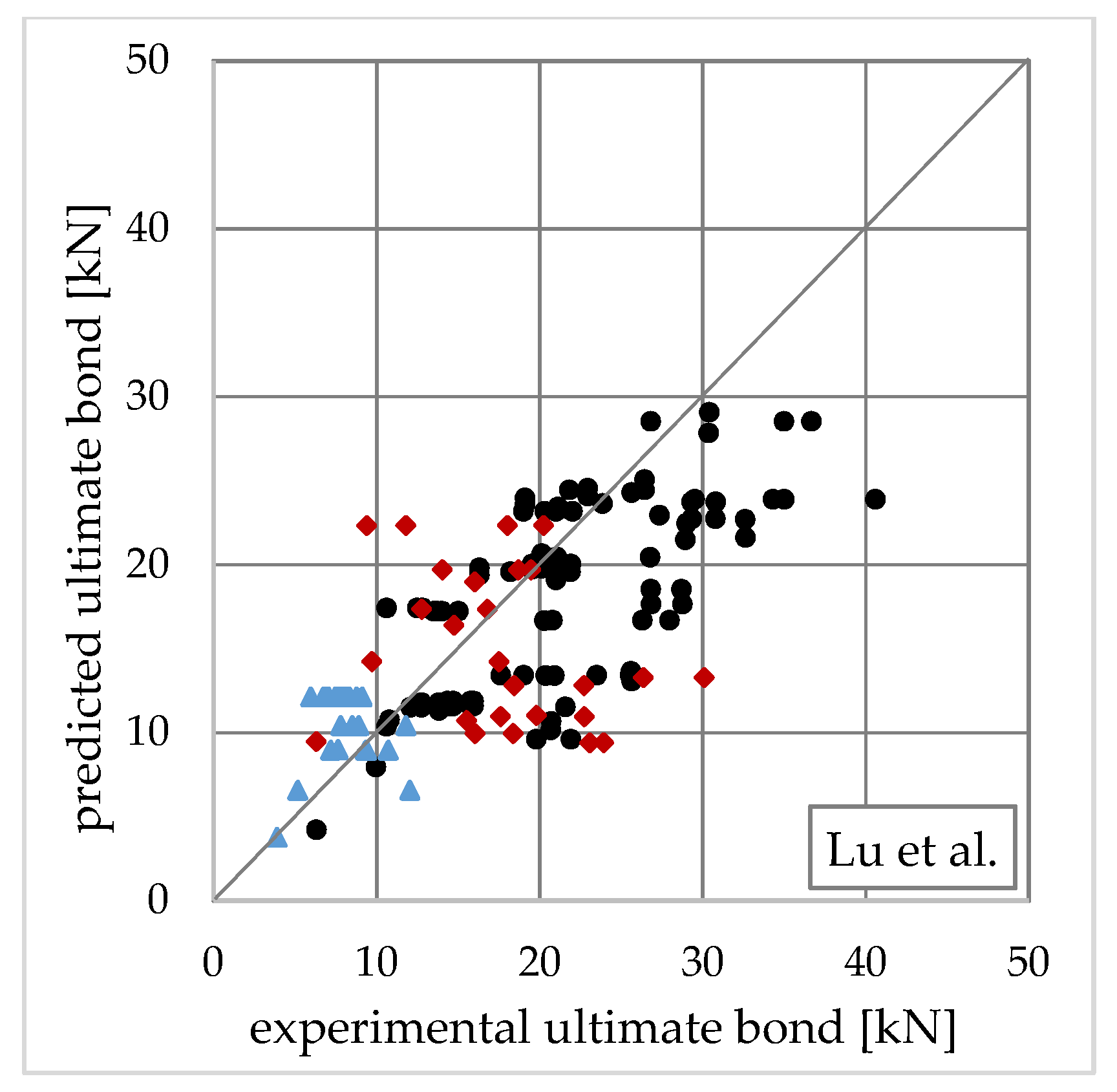
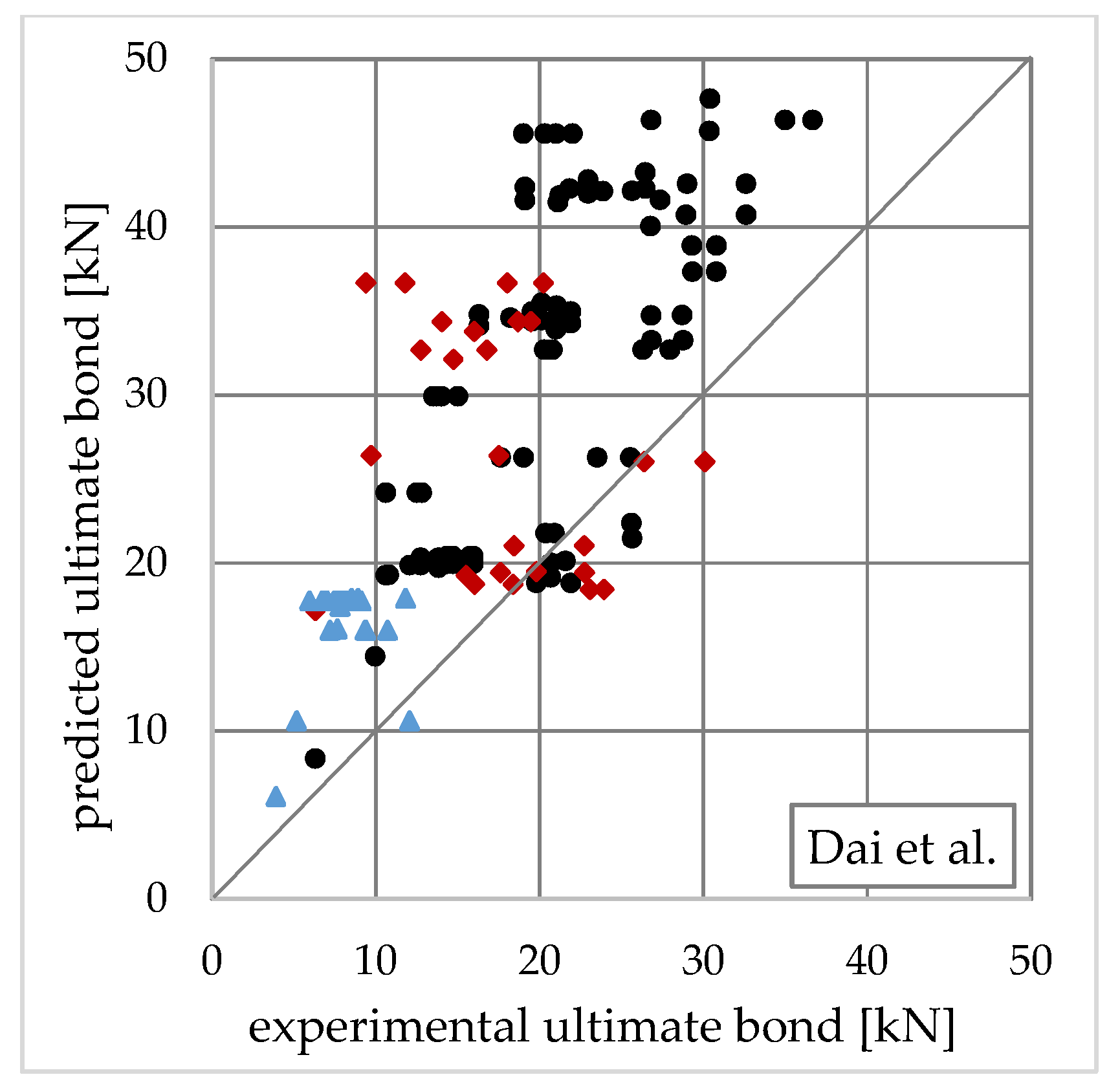

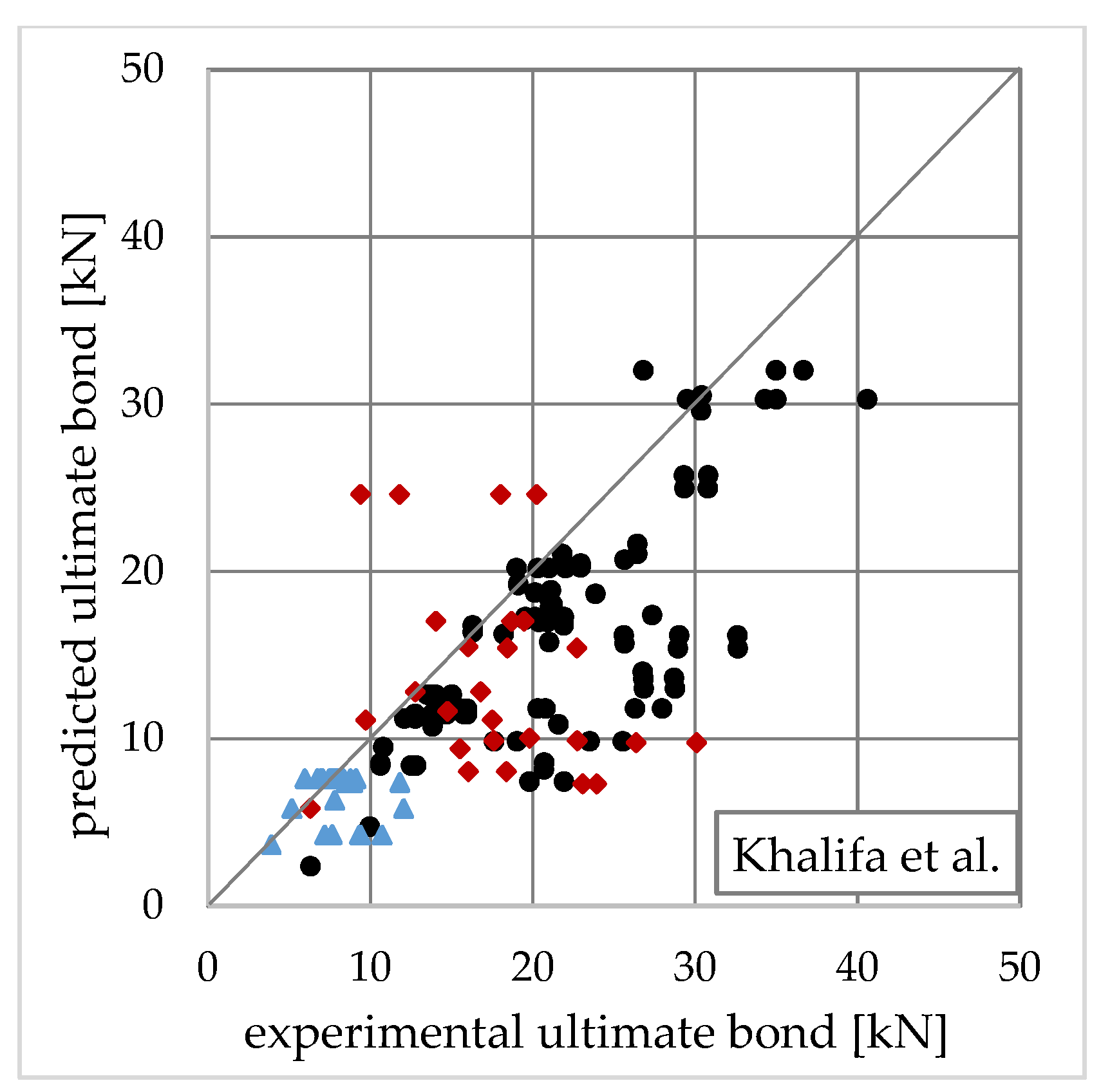

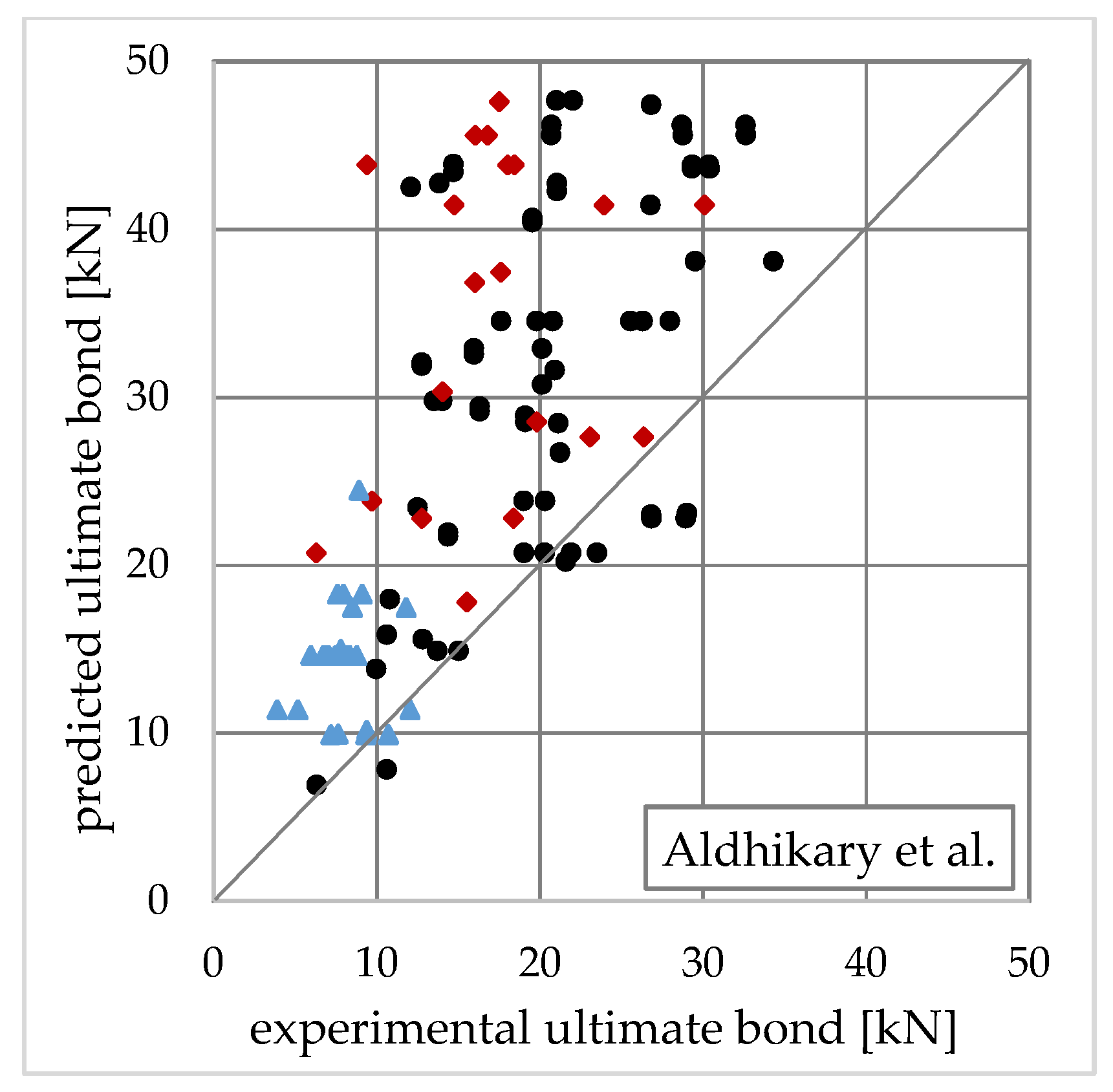
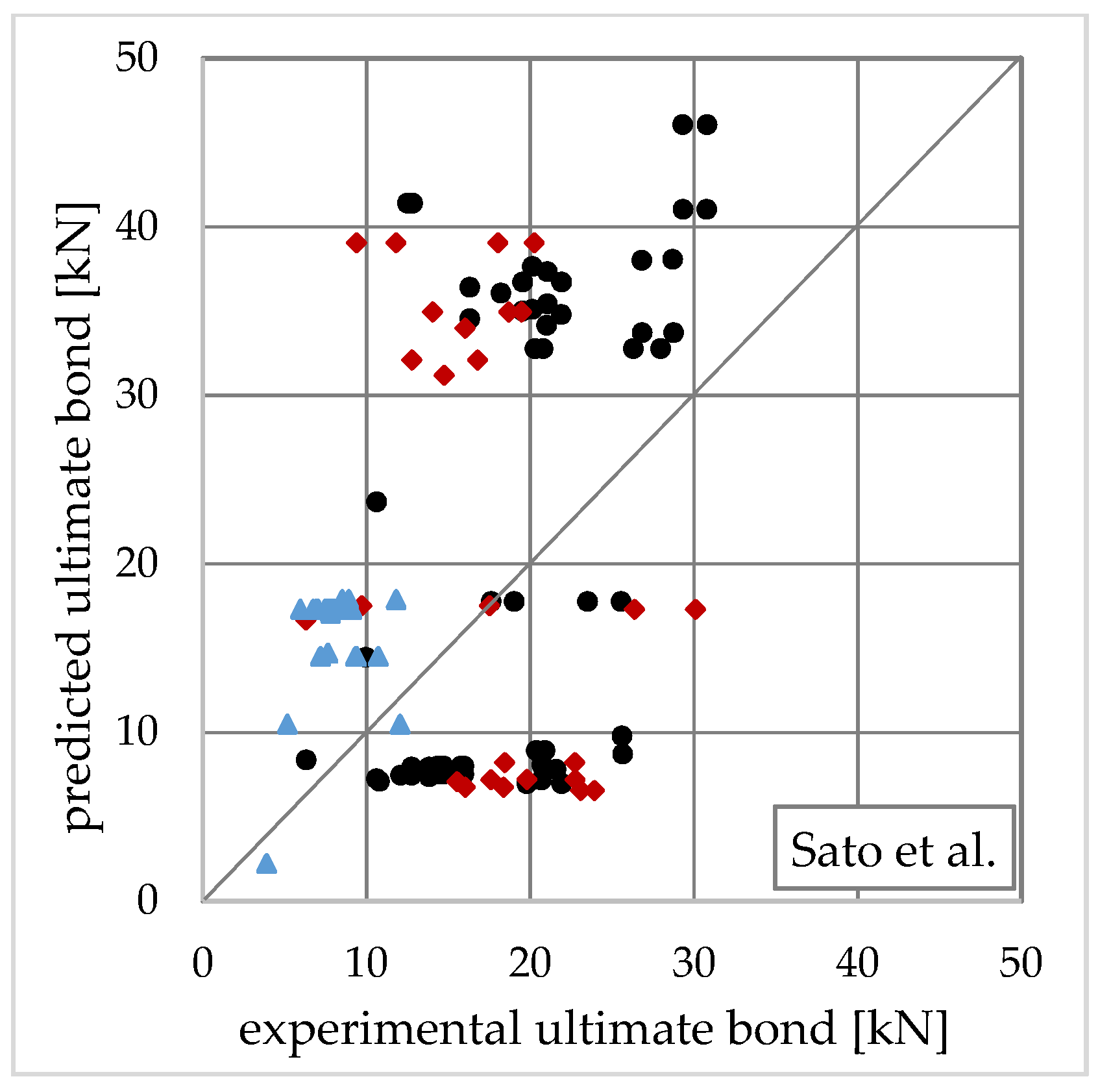

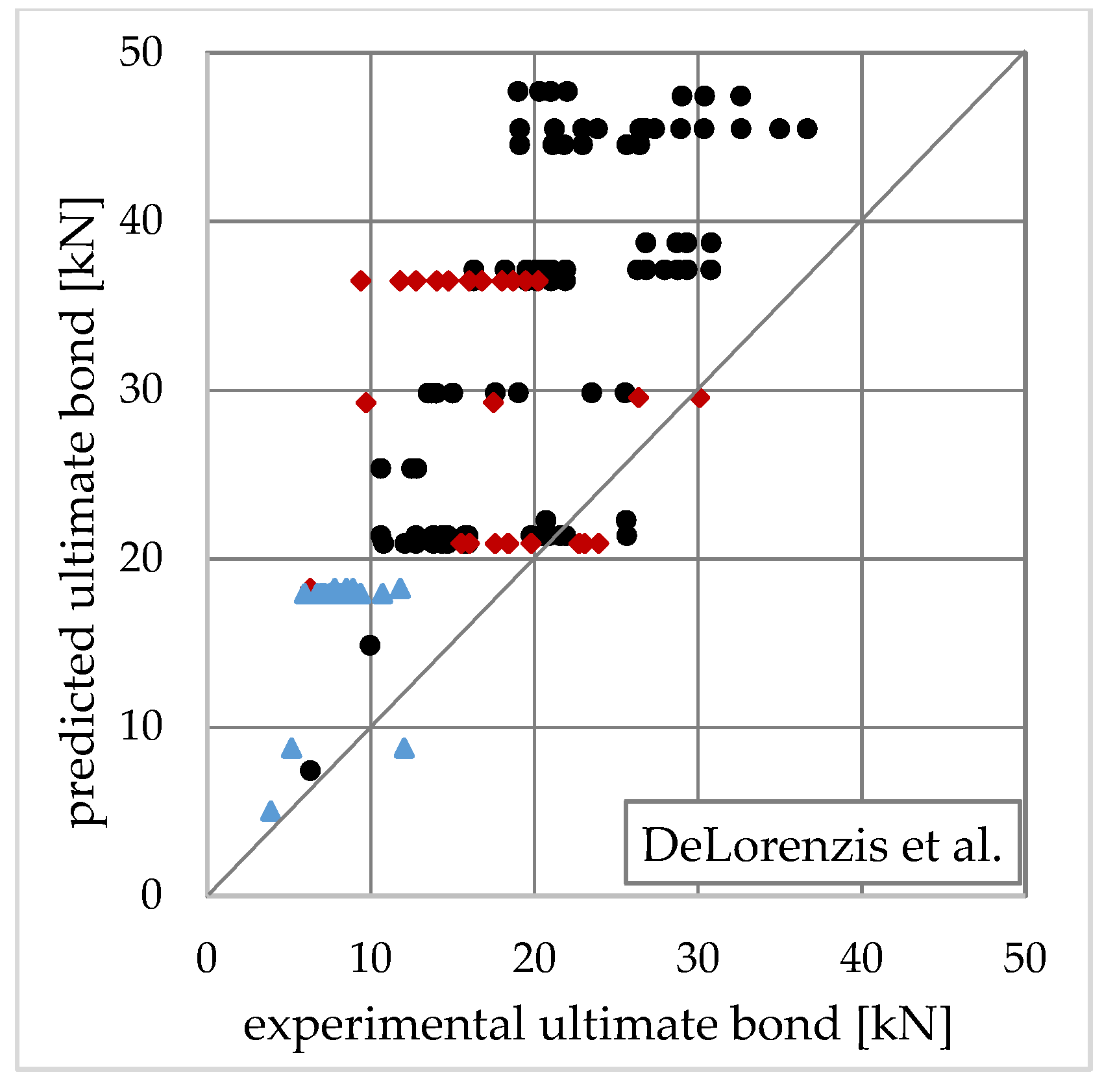





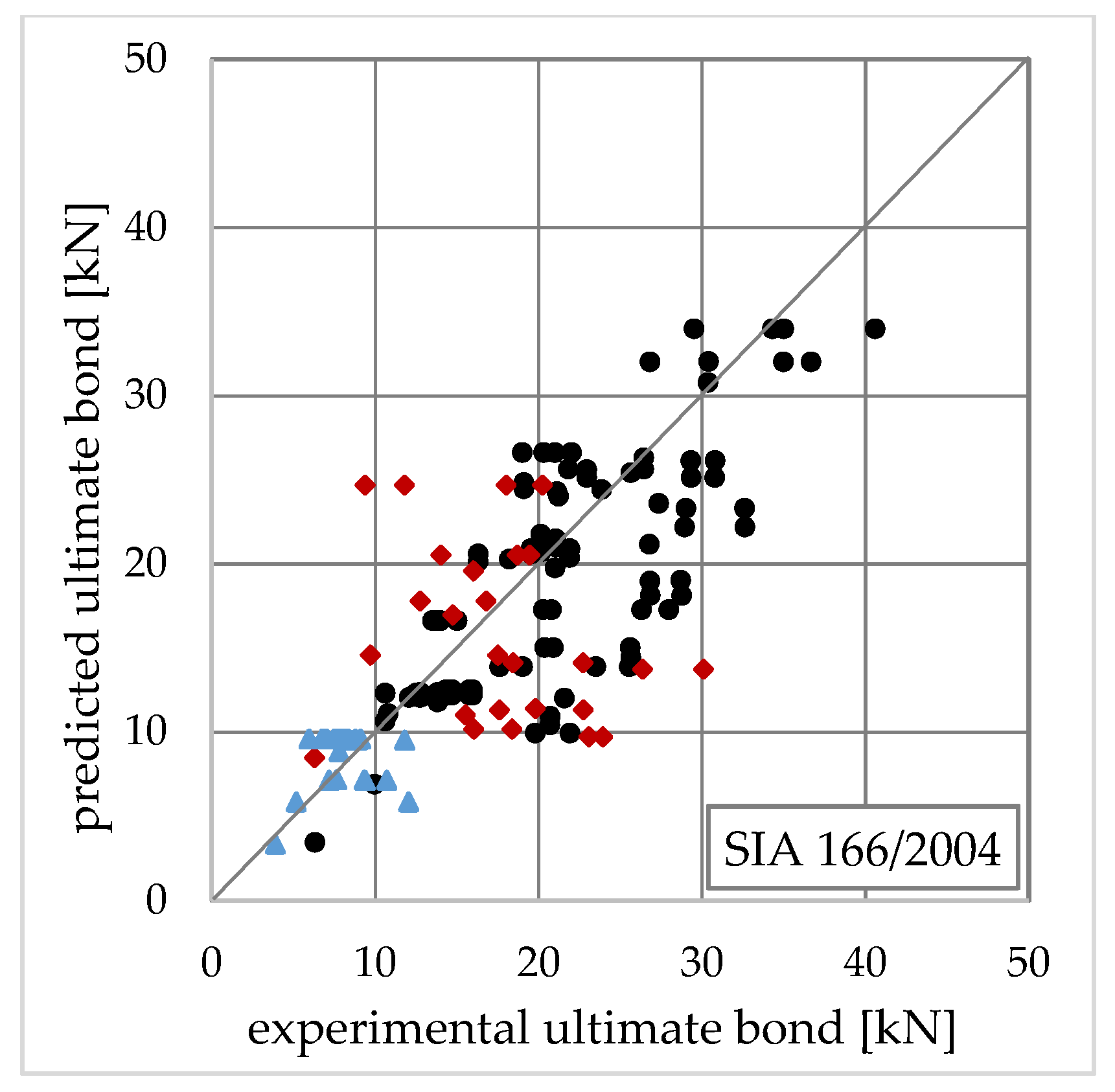


| Reference | Relationships |
|---|---|
| Tanaka [14] | |
| Hiroyuki and Wu [15] | |
| Maeda et al. [16] | |
| Taljsten [17] | , ( if ) |
| Nidermeier [18] | , |
| Neubauer and Rostasy [19] | , |
| Yuan and Wu [20] | , |
| Lu et al. [21] | , , , , , , , , |
| Dai et al. [22] | |
| Brosens and van Germet [23] | |
| Khalifa et al. [24] | |
| Yang et al. [25] | |
| Adhikary and Mutsuyoshi [26] | |
| Sato et al. [27] | |
| Chen and Teng [28] | , , |
| DeLorenzis et al. [29] | |
| Seracino et al. [30] | , , |
| Camli and Binici [31] | , , , |
| Document | Relationships |
|---|---|
| TR55/2000 [33] | , |
| Fib Bulletin 14/2001 [34] | , , , , , |
| JCI 2003 [35] | , |
| SIA 166/2004 [36] | , |
| CNR-DT200R1/13 [37] | , , |
| Fib Bulletin 90/2019 [38] | ,, |
| Reference | Number of Tested Specimens | (mm) | (MPa) | (mm) | (mm) | (mm) | (GPa) |
|---|---|---|---|---|---|---|---|
| Figeys [41] 1 | 7 | 100 | 35 | 95 | 0.601 | 150–200 | 177.6 |
| Mantana [42] 1 | 12 | 191 | 14.8 | 51 | 0.483 | 102–305 | 179.1 |
| Mitoldis [43] 1 | 8 | 100 | 22.4 | 50–80 | 0.562 | 150–300 | 221.4 |
| Napoli [44] 1 | 19 | 200 | 15.2–39.7 | 100 | 0.084–0.381 | 150–300 | 206.6 |
| Ascione [39] 1 | 129 | 200 | 13–45 | 20–100 | 0.084–0.381 | 100–350 | 190 |
| Ascione [45] 1 | 62 | 200 | 19.3–25.6 | 100 | 0.084–0.381 | 100–350 | 182.1–183.4 |
| Valluzzi [46] 2 | 63 | 120 | 19.8 | 50 | 0.231 | 160 | 195.1 |
| Panizza [47] 2 | 3 | 120 | 8.24 | 50 | 0.227 | 195 | 200.2 |
| Grande [48] 2 | 13 | 120 | 38.5 | 25 | 0227 | 160 | 190 |
| de Felice [49] 2 | 21 | 120 | 8.2–19.8 | 50 | 0.231 | 195–200 | 195.1 |
| Napoli [44] 2 | 14 | 120 | 14.7–18.5 | 50 | 0.254 | 200–280 | 183.4 |
| Ascione [50] 3 | 83 | 200 | 13–40 | 50–100 | 0.084–0.254 | 100–350 | 182.1–183.4 |
| Model | Mean | SD | PCC | % Uncertainty |
|---|---|---|---|---|
| Tanaka [14] | 0.699 | 0.263 | 0.220 | 15% |
| Hiroyuki and Wu [15] | 0.746 | 0.218 | 0.503 | 13% |
| Maeda et al. [16] | 1.14 | 0.241 | 0.751 | 66% |
| Taljsten [17] | 0.761 | 0.193 | 0.748 | 20% |
| Nidermeier [18] | 0.763 | 0.244 | 0.629 | 17% |
| Neubauer and Rostasy [19] | 0.980 | 0.313 | 0.629 | 45% |
| Yuan and Wu [20] | 0.763 | 0.195 | 0.747 | 11% |
| Lu et al. [21] | 0.873 | 0.234 | 0.676 | 27% |
| Dai et al. [22] | 1.55 | 0.372 | 0.734 | 91% |
| Brosens and van Germet [23] | 0.937 | 0.478 | 0.408 | 36% |
| Khalifa et al. [24] | 0.754 | 0.197 | 0.729 | 8% |
| Yang et al. [25] | 0.528 | 0.166 | 0.657 | 0% |
| Adhikary and Mutsuyoshi [26] | 2.00 | 0.906 | 0.476 | 89% |
| Sato et al. [27] | 1.81 | 1.22 | 0.573 | 68% |
| Chen and Teng [28] | 0.882 | 0.202 | 0.726 | 30% |
| DeLorenzis et al. [29] | 1.63 | 0.389 | 0.728 | 95% |
| Seracino et al. [30] | 0.752 | 0.196 | 0.716 | 13% |
| Camli and Binici [31] | 1.14 | 0.246 | 0.745 | 67% |
| TR55/2000 [33] | 0.502 | 0.197 | 0.609 | 3% |
| Fib Bulletin 14/2001 [34] | 0.821 | 0.268 | 0.632 | 23% |
| JCI 2003 [35] | 0.941 | 0.263 | 0.738 | 39% |
| SIA 166/2004 [36] | 0.911 | 0.219 | 0.756 | 34% |
| CNR-DT200R1/13 [37] | 0.928 | 0.264 | 0.718 | 43% |
| Fib Bulletin 90/2019 [38] | 0.962 | 0.233 | 0.755 | 45% |
| Model | Mean | SD | PCC | % Uncertainty |
|---|---|---|---|---|
| Tanaka [14] | 0.911 | 0.209 | 0.330 | 58% |
| Hiroyuki and Wu [15] | 0.869 | 0.202 | 0.339 | 23% |
| Maeda et al. [16] | 1.34 | 0.322 | 0.416 | 87% |
| Taljsten [17] | 0.764 | 0.202 | 0.339 | 29% |
| Nidermeier [18] | 1.04 | 0.339 | 0.215 | 68% |
| Neubauer and Rostasy [19] | 1.34 | 0.435 | 0.215 | 81% |
| Yuan and Wu [20] | 0.764 | 0.202 | 0.339 | 29% |
| Lu et al. [21] | 1.13 | 0.277 | 0.358 | 74% |
| Dai et al. [22] | 1.87 | 0.393 | 0.453 | 90% |
| Brosens and van Germet [23] | 1.208 | 0.663 | −0.087 | 71% |
| Khalifa et al. [24] | 0.726 | 0.232 | 0.232 | 16% |
| Yang et al. [25] | 0.719 | 0.223 | 0.223 | 45% |
| Adhikary and Mutsuyoshi [26] | 1.78 | 0.664 | 0.116 | 87% |
| Sato et al. [27] | 1.73 | 0.499 | 0.499 | 87% |
| Chen and Teng [28] | 1.04 | 0.222 | 0.441 | 74% |
| DeLorenzis et al. [29] | 1.91 | 0.47 | 0.424 | 90% |
| Seracino et al. [30] | 0.954 | 0.218 | 0.414 | 68% |
| Camli and Binici [31] | 1.271 | 0.351 | 0.380 | 84% |
| TR55/2000 [33] | 0.655 | 0.231 | 0.229 | 13% |
| Fib Bulletin 14/2001 [34] | 1.20 | 0.392 | 0.218 | 77% |
| JCI 2003 [35] | 0.943 | 0.238 | 0.379 | 65% |
| SIA 166/2004 [36] | 0.954 | 0.22 | 0.404 | 65% |
| CNR-DT200R1/13 [37] | 1.41 | 0.432 | 0.232 | 81% |
| Fib Bulletin 90/2019 [38] | 1.09 | 0.249 | 0.411 | 77% |
| Model | Mean | SD | PCC | % Uncertainty |
|---|---|---|---|---|
| Tanaka [14] | 0.882 | 0.344 | 0.049 | 27% |
| Hiroyuki and Wu [15] | 0.984 | 0.277 | 0.526 | 42% |
| Maeda et al. [16] | 1.31 | 0.57 | −0.174 | 54% |
| Taljsten [17] | 0.848 | 0.499 | −0.241 | 35% |
| Nidermeier [18] | 0.812 | 0.482 | −0.264 | 31% |
| Neubauer and Rostasy [19] | 1.043 | 0.619 | −0.264 | 50% |
| Yuan and Wu [20] | 0.851 | 0.501 | −0.241 | 35% |
| Lu et al. [21] | 0.965 | 0.499 | −0.274 | 50% |
| Dai et al. [22] | 1.71 | 0.832 | −0.245 | 69% |
| Brosens and van Germet [23] | 1.16 | 0.802 | 0.099 | 46% |
| Khalifa et al. [24] | 0.861 | 0.539 | −0.215 | 27% |
| Yang et al. [25] | 0.589 | 0.339 | −0.248 | 8% |
| Adhikary and Mutsuyoshi [26] | 2.68 | 1.43 | 0.190 | 96% |
| Sato et al. [27] | 1.41 | 1.09 | −0.354 | 54% |
| Chen and Teng [28] | 1.01 | 0.52 | −0.274 | 50% |
| DeLorenzis et al. [29] | 1.83 | 0.850 | −0.210 | 77% |
| Seracino et al. [30] | 0.821 | 0.441 | −0.275 | 27% |
| Camli and Binici [31] | 1.39 | 0.52 | 0.146 | 62% |
| TR55/2000 [33] | 0.554 | 0.332 | −0.061 | 8% |
| Fib Bulletin 14/2001 [34] | 0.937 | 0.007 | −0.261 | 42% |
| JCI 2003 [35] | 1.02 | 0.604 | −0.259 | 50% |
| SIA 166/2004 [36] | 1.01 | 0.541 | −0.244 | 50% |
| CNR-DT200R1/13 [37] | 1.02 | 0.595 | −0.220 | 50% |
| Fib Bulletin 90/2019 [38] | 1.08 | 0.58 | −0.273 | 50% |
| Model | SRP | CFRP | ||
|---|---|---|---|---|
| Tutanji et al. [32] | Wu et al. [51] | Anil et al. [52] | ||
| Tanaka [14] | 0.699 | 0.48 | 0.68 | 0.98 |
| Hiroyuki and Wu [15] | 0.746 | 0.476 | 0.94 | |
| Maeda et al. [16] | 1.14 | 0.929 | 0.95 | 1.25 |
| Taljsten [17] | 0.761 | 0.761 | ||
| Nidermeier [18] | 0.763 | 0.73 | 0.87 | |
| Neubauer and Rostasy [19] | 0.980 | 1.12 | 1.10 | 1.23 |
| Yuan and Wu [20] | 0.763 | 0.763 | ||
| Lu et al. [21] | 0.873 | 0.819 | ||
| Dai et al. [22] | 1.55 | 1.49 | ||
| Brosens and van Germet [23] | 0.937 | 0.718 | ||
| Khalifa et al. [24] | 0.754 | 0.798 | 0.92 | 0.76 |
| Yang et al. [25] | 0.528 | 0.841 | 0.94 | 0.89 |
| Adhikary Mutsuyoshi [26] | 2.00 | 1.19 | ||
| Sato et al. [27] | 1.81 | 1.28 | 1.45 | 1.03 |
| Chen and Teng [28] | 0.882 | 0.857 | 0.89 | 0.91 |
| Classification Category | DPC Points | |
|---|---|---|
| Extremely dangerous | ≥2.00 | 10 |
| Dangerous | 1.15–2.00 | 5 |
| Appropriate and safe | 0.85–1.15 | 0 |
| Conservative | 0.5–0.85 | 1 |
| Extremely conservative | <0.5 | 2 |
| >2 | 1.15–2 | 0.85–1.15 | 0.5–0.85 | <0.5 | Total DPC | |
|---|---|---|---|---|---|---|
| TR55/2000 [33] | - | - | 6 | 36 | 49 | 134 |
| Fib Bulletin 14/2001 [34] | - | 11 | 31 | 38 | 11 | 115 |
| JCI 2003 [35] | - | 20 | 33 | 34 | 4 | 142 |
| SIA 166/2004 [36] | - | 15 | 41 | 34 | 1 | 111 |
| CNR-DT200R1/13 [37] | - | 20 | 37 | 29 | 5 | 139 |
| Fib Bulletin 90/2019 [38] | - | 21 | 40 | 29 | 1 | 136 |
| >2 | 1.15–2 | 0.85–1.15 | 0.5–0.85 | <0.5 | Total DPC | |
|---|---|---|---|---|---|---|
| TR55/2000 [33] | - | 1 | 11 | 13 | 5 | 28 |
| Fib Bulletin 14/2001 [34] | 3 | 18 | 6 | 2 | 1 | 124 |
| JCI 2003 [35] | - | 15 | 9 | 5 | 1 | 82 |
| SIA 166/2004 [36] | - | 14 | 10 | 4 | 2 | 78 |
| CNR-DT200R1/13 [37] | 8 | 16 | 4 | 1 | 1 | 163 |
| Fib Bulletin 90/2019 [38] | - | 20 | 7 | 2 | 1 | 104 |
Publisher’s Note: MDPI stays neutral with regard to jurisdictional claims in published maps and institutional affiliations. |
© 2020 by the author. Licensee MDPI, Basel, Switzerland. This article is an open access article distributed under the terms and conditions of the Creative Commons Attribution (CC BY) license (http://creativecommons.org/licenses/by/4.0/).
Share and Cite
Krzywoń, R. Assessment of Existing Bond Models for Externally Bonded SRP Composites. Appl. Sci. 2020, 10, 8593. https://doi.org/10.3390/app10238593
Krzywoń R. Assessment of Existing Bond Models for Externally Bonded SRP Composites. Applied Sciences. 2020; 10(23):8593. https://doi.org/10.3390/app10238593
Chicago/Turabian StyleKrzywoń, Rafał. 2020. "Assessment of Existing Bond Models for Externally Bonded SRP Composites" Applied Sciences 10, no. 23: 8593. https://doi.org/10.3390/app10238593





